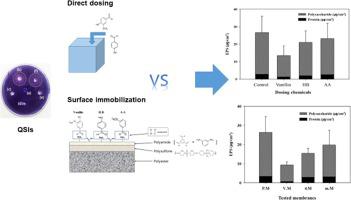Separation and Purification Technology ( IF 8.1 ) Pub Date : 2020-09-15 , DOI: 10.1016/j.seppur.2020.117736 Jaehyeok Kim , MinGyu Shin , WonJung Song , SangHee Park , Junhee Ryu , Jaehyun Jung , SuYoung Choi , Youngjae Yu , Jihyang Kweon , Jung-Hyun Lee

|
Quorum sensing inhibitors (QSIs) have shown promising results in reducing biofouling in various membrane systems. Vanillin was shown to inhibit QS of gram-negative bacteria during water treatment. Here, four vanillin-analogues with various chemical structures were used to understand the QS mechanisms in biofilm reduction and to compare direct dosing and surface modification of the inhibitors. Biofilm reduction, evaluated based on the content of extracellular polymeric substances (EPS), was the greatest with vanillin (49%) and occurred to some extent with 4-hydroxybenzaldehyde (21%) and m-anisaldehyde (13%), when direct dosing was applied. Experiments using vanillin-analogues revealed crucial roles of the chemical structure and functional groups on the inhibition of biofilm formation. The aldehyde and hydroxyl groups in both vanillin and 4-hydroxybenzaldehyde might be essential for QS inhibition. Further, surface modification with interfacial polymerization and immobilization of QSIs was conducted to evaluate their anti-biofouling capabilities. Surface modification was markedly effective in reducing biofilm formation; the EPS content of biofilms formed on vanillin-incorporated membranes was reduced by 64%. Additionally, the modified membranes showed a water flux comparable to that of pristine membranes, showing little possibility to block membrane pores during modification procedures. These findings will aid the development of QSI-based techniques for biofouling mitigation.
中文翻译:

群体感应抑制剂在改善聚酰胺反渗透膜抗生物结垢方面的应用:直接注入与表面改性
群体感应抑制剂(QSI)在减少各种膜系统中的生物结垢方面显示出令人鼓舞的结果。香兰素在水处理过程中可抑制革兰氏阴性细菌的QS。在这里,使用四个具有不同化学结构的香兰素类似物来了解生物膜还原过程中的QS机制,并比较抑制剂的直接剂量和表面修饰。根据细胞外聚合物质(EPS)的含量评估的生物膜减少量,香草醛(49%)最大,而4-羟基苯甲醛(21%)和m-茴香醛(13%),当直接给药时。使用香兰素类似物的实验揭示了化学结构和官能团在抑制生物膜形成中的关键作用。香兰素和4-羟基苯甲醛中的醛和羟基对于抑制QS可能是必不可少的。此外,还进行了界面聚合和QSI固定化的表面改性,以评估其抗生物结垢能力。表面改性在减少生物膜形成方面非常有效;香草醛结合膜上形成的生物膜的EPS含量降低了64%。另外,改性膜显示出与原始膜相当的水通量,在改性过程中几乎没有堵塞膜孔的可能性。











































 京公网安备 11010802027423号
京公网安备 11010802027423号